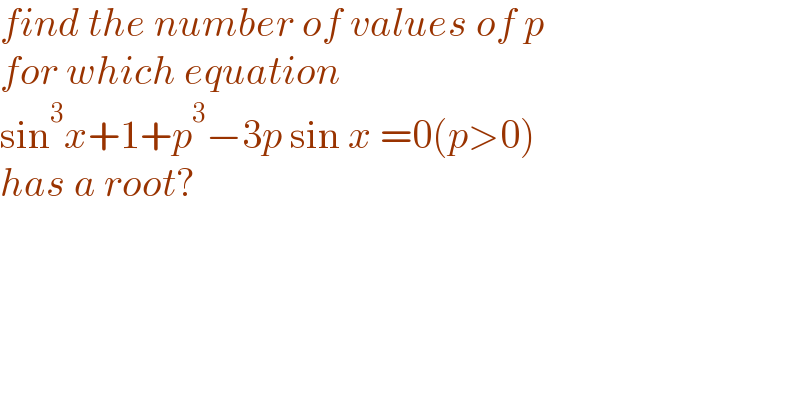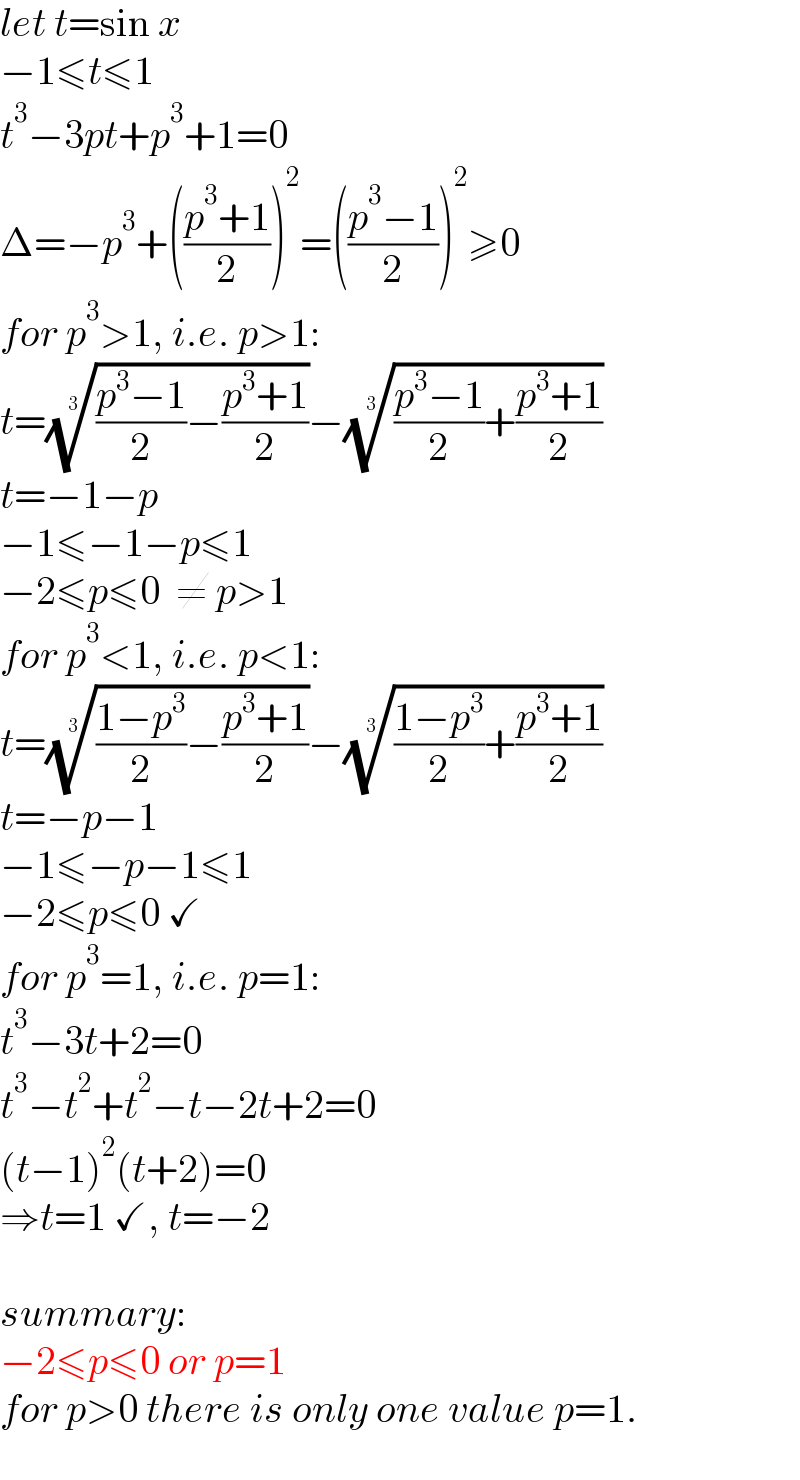
Question Number 158523 by gsk2684 last updated on 05/Nov/21

$${find}\:{the}\:{number}\:{of}\:{values}\:{of}\:{p} \\ $$ $${for}\:{which}\:{equation}\: \\ $$ $$\mathrm{sin}^{\mathrm{3}} {x}+\mathrm{1}+{p}^{\mathrm{3}} −\mathrm{3}{p}\:\mathrm{sin}\:{x}\:=\mathrm{0}\left({p}>\mathrm{0}\right) \\ $$ $${has}\:{a}\:{root}? \\ $$
Answered by mr W last updated on 05/Nov/21

$${let}\:{t}=\mathrm{sin}\:{x} \\ $$ $$−\mathrm{1}\leqslant{t}\leqslant\mathrm{1} \\ $$ $${t}^{\mathrm{3}} −\mathrm{3}{pt}+{p}^{\mathrm{3}} +\mathrm{1}=\mathrm{0} \\ $$ $$\Delta=−{p}^{\mathrm{3}} +\left(\frac{{p}^{\mathrm{3}} +\mathrm{1}}{\mathrm{2}}\right)^{\mathrm{2}} =\left(\frac{{p}^{\mathrm{3}} −\mathrm{1}}{\mathrm{2}}\right)^{\mathrm{2}} \geqslant\mathrm{0} \\ $$ $${for}\:{p}^{\mathrm{3}} >\mathrm{1},\:{i}.{e}.\:{p}>\mathrm{1}: \\ $$ $${t}=\sqrt[{\mathrm{3}}]{\frac{{p}^{\mathrm{3}} −\mathrm{1}}{\mathrm{2}}−\frac{{p}^{\mathrm{3}} +\mathrm{1}}{\mathrm{2}}}−\sqrt[{\mathrm{3}}]{\frac{{p}^{\mathrm{3}} −\mathrm{1}}{\mathrm{2}}+\frac{{p}^{\mathrm{3}} +\mathrm{1}}{\mathrm{2}}} \\ $$ $${t}=−\mathrm{1}−{p} \\ $$ $$−\mathrm{1}\leqslant−\mathrm{1}−{p}\leqslant\mathrm{1} \\ $$ $$−\mathrm{2}\leqslant{p}\leqslant\mathrm{0}\:\:\neq\:{p}>\mathrm{1} \\ $$ $${for}\:{p}^{\mathrm{3}} <\mathrm{1},\:{i}.{e}.\:{p}<\mathrm{1}: \\ $$ $${t}=\sqrt[{\mathrm{3}}]{\frac{\mathrm{1}−{p}^{\mathrm{3}} }{\mathrm{2}}−\frac{{p}^{\mathrm{3}} +\mathrm{1}}{\mathrm{2}}}−\sqrt[{\mathrm{3}}]{\frac{\mathrm{1}−{p}^{\mathrm{3}} }{\mathrm{2}}+\frac{{p}^{\mathrm{3}} +\mathrm{1}}{\mathrm{2}}} \\ $$ $${t}=−{p}−\mathrm{1} \\ $$ $$−\mathrm{1}\leqslant−{p}−\mathrm{1}\leqslant\mathrm{1} \\ $$ $$−\mathrm{2}\leqslant{p}\leqslant\mathrm{0}\:\checkmark \\ $$ $${for}\:{p}^{\mathrm{3}} =\mathrm{1},\:{i}.{e}.\:{p}=\mathrm{1}: \\ $$ $${t}^{\mathrm{3}} −\mathrm{3}{t}+\mathrm{2}=\mathrm{0} \\ $$ $${t}^{\mathrm{3}} −{t}^{\mathrm{2}} +{t}^{\mathrm{2}} −{t}−\mathrm{2}{t}+\mathrm{2}=\mathrm{0} \\ $$ $$\left({t}−\mathrm{1}\right)^{\mathrm{2}} \left({t}+\mathrm{2}\right)=\mathrm{0} \\ $$ $$\Rightarrow{t}=\mathrm{1}\:\checkmark,\:{t}=−\mathrm{2} \\ $$ $$ \\ $$ $${summary}: \\ $$ $$−\mathrm{2}\leqslant{p}\leqslant\mathrm{0}\:{or}\:{p}=\mathrm{1} \\ $$ $${for}\:{p}>\mathrm{0}\:{there}\:{is}\:{only}\:{one}\:{value}\:{p}=\mathrm{1}. \\ $$
Commented bygsk2684 last updated on 12/Nov/21

$${thank}\:{you}\:{sir}\:\left(°\smile°\right) \\ $$
